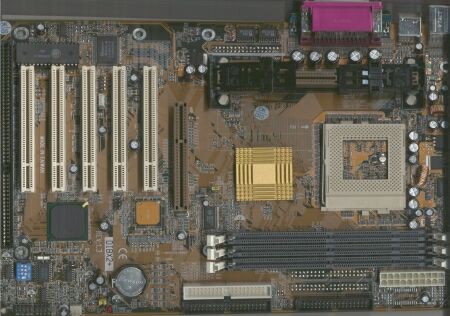The Best For Freaks: 10 Motherboards using the BX-Chipset
Azza DIBX2+ And DIBX4
Board Revision: 1.3
BIOS Version: ?
Both Azza boards (DIBX2+ and DIBX4) are ready for all kind of CPUs, as they are the only dual CPU motherboards of this review. But they are no classic dual boards. Azza equipped their boards with both the Slot-1 and a Socket 370. This way you get the chance to use every Intel CPU type except the Xeon. All upgraders get of course the best benefit, as they can keep using their existing Slot-1 CPU and upgrade to a Socket 370 model as soon as the prices decrease. Or maybe you can get a Pentium III Slot-1 cheaper than the FC-PGA model.
All features are up to date: Three DIMM sockets, one ISA and four PCI-Slots are waiting to be equipped. The DIBX2+ comes with a fifth PCI slot, but does not have the UltraDMA/66 controller like the DIBX4.
Good work also after a look at the details, as the retention mechanism for the Slot-1 is already mounted and can easily be opened in order to remove the CPU. Every connector has been labeled properly, yet beginners should take a quick look into the manual, because some descriptions on the board are shortened. Both motherboards come with a status LED, which is active as soon as you apply power to the board. The CPU settings have to be done via jumpers (system speed) and DIP switches (multiplier).
Jumpers JP11 and JP12 have an influence on the processor voltage. The first one rises the voltage by 0.05V, which is usually helpful for overclocking. JP12 lets you select the voltage range. If it is open, the board will provide max. 2.05V. Closed, the CPU can be supplied with up to 3.5V. According to Azza, this jumper has been introduced in order to save modern CPUs from over-voltage.
In the end, both Azza boards left a pretty good impression, which is a bit uncommon for boards of a less-known brand. The prices will most likely be clearly under the level of Asus and some others.
Get Tom's Hardware's best news and in-depth reviews, straight to your inbox.

Patrick Schmid was the editor-in-chief for Tom's Hardware from 2005 to 2006. He wrote numerous articles on a wide range of hardware topics, including storage, CPUs, and system builds.
